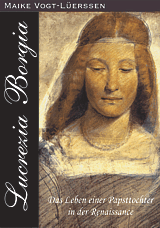
Leonardo da Vinci, der diese Porträtzeichnung erstellt hatte, gibt die Papsttochter mit den von ihren Zeitgenossen beschriebenen charakteristischen Merkmalen, ihrem goldblonden Haar und ihrer Perlenkette, wieder. Die Kunsthistoriker der Pinacoteca Ambrosiana in Mailand sehen dagegen in diesem Porträt die mailändische Herzogin Isabella von Aragon dargestellt, obwohl Letztere in allen zeitgenössischen Quellen als "dunkelhaarige südländische Schönheit" beschrieben wird.
In letzter Zeit erhalte ich einige Anfragen besonders aus dem englisch-sprachigen Raum bezüglich dieser Zeichnung, da laut der Kunsthistoriker Leonardo da Vinci angeblich nur mit der linken Hand gezeichnet und gemalt hätte. Deshalb füge ich hier Ausschnitte meines folgenden Antwortschreibens hinzu: "Dear Mr. ... We have this very important contemporary source of a person, Antonio de Beatis, who actually visited Leonardo da Vinci in Amboise in October 1517. According to Antonio de Beatis, Leonardo had a stroke (or a heart attack) and could not use his RIGHT hand any longer. Therefore he was not able to paint any longer. Antonio de Beatis [on the 10th October 1517]: "Our master [the Cardinal Luigi of Aragon] went with the rest of us to one of the suburbs to see Messer Leonardo Vinci of Florence, an old man of more than seventy, the most outstanding painter of our day. He showed the Cardinal three pictures, one of a certain Florentine woman portrayed from life at the request of the late Magnificent Giuliano de' Medici, another of the young St. John the Baptist as a young man, and one of the Madonna and Child set in the lap of St. Anne. All three works are quite perfect, though nothing good can now be expected from his brush as he suffers from paralysis in the right hand. He has successfully trained a Milanese pupil who works extremely well. And although Messer Leonardo cannot colour with his former softness, yet he can still draw and teach." (in: The Travel Journal of Antonio de Beatis – Germany, Switzerland, the Low Countries, France and Italy, 1517-1518. Translated from the Italian by J.R. Hale and J.M.A. Lindon. Edited by J.R. Hale. London 1979, p. 132) ...
Leonardo was a born left-hander. But in the Middle Ages and Renaissance everybody born into a family (as opposed to being left on their own) was trained to use the right hand. The left hand was considered "the bad hand". This was still tradition even until the mid-20th century. None of my friends at school were allowed to write with their left hands. Like every person who was or is born left-handed, but was forced to write with their right hand, Leonardo da Vinci was very good in mirror-writing. The studies of Johanna Barbara Sattler about mirror-writing have shown that right-handed persons have, like left-handed persons, great problems to learn the mirror-writing, but left-handed persons who were forced to write with the right hand learn it easily. ... Leonardo could use both his hands because he was trained to paint with the right hand under his master Andrea del Verrocchio. Therefore when he had his stroke (or heart attack) he was unable to produce paintings like he did before. So he stopped doing it. After all he was a perfectionist. ...
Leonardo da Vinci used in his works both hands. Yet art historians tell us that he used only his left hand, even though there is no contemporary historical source supporting their claim. Therefore all works in which Leonardo used his right hand are now according to the art historians identified as works mostly of his student Giovanni Antonio Boltraffio, although we have NOT one signed work of him. This portrait of Lucrezia Borgia was made by Leonardo da Vinci, who was sent as the envoy of Isabella of Aragon ("Mona Lisa") to the wedding of her half-brother Alfonso and his bride Lucrezia Borgia to Rome in 1498. I do not think that Isabella of Aragon sent Leonardo's student Giovanni Antonio Boltraffio as her envoy to Rome. The Borgias were too important as allies for Isabella to send Boltraffio to them. The envoy had to be her best friend [and at that time already secret second husband], Leonardo."
PS: Lucrezia Borgia scheint sich übrigens zumindest bei ihrer dritten und vierten Heirat fast gleich gekleidet zu haben. Leonardo da Vinci, der Abgesandte von Isabella von Aragon, hat sie im obigen Bildnis anlässlich ihrer dritten Heirat mit Alfonso von Aragon am 21. Juli 1498 verewigt. Als sie am 28. Dezember 1501 per procura, also mittels eines Stellvertreters ihres vierten Gatten, Alfonso d'Este, erneut vermählt wurde, lesen wir über sie bei Zeitgenossen Folgendes: „Die bezaubernde Tochter Alexanders [Lucrezia Borgia] erschien in einem goldbrokatenen Gewande, dessen Schleppe junge Ehrendamen trugen, gefolgt von 50 edlen Römerinnen. Ihr goldfarbenes, über die Schulter herabwallendes Haar umschlang nur ein dünnes Band von schwarzer Seide; ihren Hals eine Perlenschnur.“ (in: Ferdinand Gregorovius: Geschichte der Stadt Rom im Mittelalter, Vom V. bis zum XVI. Jahrhundert, Band 7, Stuttgart und Berlin 19226, S. 451). Vergleichen Sie einmal diese Beschreibung mit der obigen Zeichnung.

